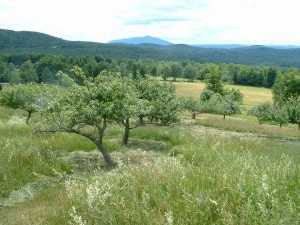I was in the passenger seat, being driven up a driveway by a real estate agent in 1995. I looked southward through the open car window toward a wide valley encircled by beautiful mountains and fell in love instantaneously. Many years later, I look at those familiar mountains (Croydon Peak and Grantham Mountain), the undulating valleys, the wispy fog after a thunderstorm, the velvety evergreen/hardwood forests, drifting tendrils of smoke from distant neighbors’ chimneys, and the hawks riding the thermals, and I’m still in love.
Had I looked northward while in that car, I would have seen a tangled and neglected orchard. That orchard had been planted hurriedly and haphazardly by the previous owner of our tree farm in Meriden, New Hampshire. Though the varietal names of those apple trees are lost to us, we do know that every autumn the orchard gives us a few gallons of cider, a quick bite as we mow the grass, or a giggle as we watch a turkey stretch its neck and jump high to grab its own bite of the juicy fruit.
When we bought our land on the western flank of Morgan Hill, we armed ourselves with pruning saws and loppers, determined to create order out of chaos. With the help of our neighbor during a cold and rainy November, we transplanted a few trees for a straighter mowing path between trunks and branches. We sadly cut down the dead and dying trees that forgave the deed with the best firewood ever. We learned that we could prune one-third of the tree per year and discovered that the rejuvenation of these 150 or so trees would take several years. The pruning has to be done in the winter when the tree is dormant and before the buds open in the spring.
We left the prunings in the snow for the deer to munch after we left work for the day. I imagined the deer impatiently waiting in the forest next to the orchard looking at their watches and muttering, “Aren’t they done yet? Hurry up, I’m hungry!”
In the spring, we were eager for our bees to fly out and pollinate the blossoms. We learned that bats, hummingbirds, and butterflies are also part of the army of pollinators. We had some very cold, wet, and windy springs in those early years for those small, unsung heroes to navigate. Thus, we had few apples in those years. But this past year, 2007, we had more apples than ever before because the spring weather was perfect for blossom and pollinator alike
Our orchard continues to provide for the deer, turkey, bear, and anyone (or thing) that wants a delicious bite. It has been 12 years of work, but every minute spent in toil has been a great joy for all of the creatures that enjoy this piece of earth.


